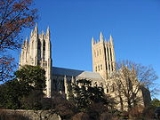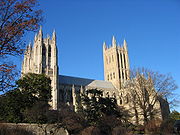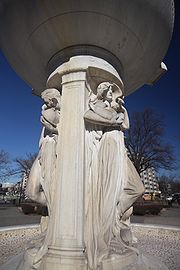
Constantine Seferlis
Encyclopedia
Constantine L. Seferlis (1930 – 2005) is acknowledged as a master sculptor and stone carver whose works exemplified a group of public monumental artists in the United States during the second half of the 20th century. Many of these stone masters were immigrants, primarily from southern Europe, including Italy and Greece, and they trained and worked in the classical milieu. Seferlis himself was born near Sparta, Greece, and, because of his precocious talent, was enrolled at an early age in the National Academy of Fine Arts in Athens. It was at the National Academy that Seferlis developed his artistic voice, his naturalistic style, and his love for the medium of stone.
 Seferlis immigrated to the Washington, D.C.
Seferlis immigrated to the Washington, D.C.
, area in the latter part of the 1950s. His talent, grace, and humor were already evident in the sculptures he carved at the National Shrine of the Immaculate Conception, his first job in the United States. Two years later, his art truly began to blossom and mature as he started work on the National Cathedral.
Over the next two decades, he worked on the Cathedral’s various ongoing interior and exterior construction projects. The National Cathedral was declared completed in 1990, almost nine decades after the cornerstone was laid, though restoration, elaboration, and intense maintenance continue to the present day. Seferlis’ contributions to the Cathedral take the form of limestone gargoyle
s, grotesque
s, capitals, pinnacles, saints, angels, keystones, bosses, column capitals, and freestanding figural sculptures of historical personages such as Helen Keller
and Pope John XXIII
.
 In addition to the Shrine and the Cathedral, Seferlis enthusiastically undertook a number of high-profile restoration projects on both public and private buildings. He carved elaborate capitals used in restoring the Corinthian columns of the east front of the U.S. Capitol building. Under the auspices of the National Park Service, he worked on restoring or replacing a number of the almost 200 historical commemorative stones that line the granite interior of the Washington Monument
In addition to the Shrine and the Cathedral, Seferlis enthusiastically undertook a number of high-profile restoration projects on both public and private buildings. He carved elaborate capitals used in restoring the Corinthian columns of the east front of the U.S. Capitol building. Under the auspices of the National Park Service, he worked on restoring or replacing a number of the almost 200 historical commemorative stones that line the granite interior of the Washington Monument
. For the Smithsonian Institution
, Seferlis worked on renovating the façade of the emblematic Smithsonian Castle; carved exterior gates and finials; and restored the statue of St. Dunstan donated to the Institution by Westminster Abbey
.
 He also restored and renovated a number of famous fountains in the Washington, D.C., area, including the Dupont Circle
He also restored and renovated a number of famous fountains in the Washington, D.C., area, including the Dupont Circle
fountain and the swan fountain in the French parterre at Hillwood Museum and Gardens (the Washington residence of Marjorie Merriweather Post
).
Seferlis mounted several major exhibitions at prestigious venues, including the National Academy of Design and National Sculpture Society in New York. As a result of his highly regarded figural and ornamental sculptures, he was awarded a number of sought-after prizes in recognition of his artistic contributions. In 1971, he was inducted into the National Sculpture Society, followed by membership in the National Academy of Design
in 1974.
Seferlis’ works, along with those of his colleagues, were highlighted for a wider audience in the documentary, “The Stone Carvers” (1984). This half-hour-long film won the Academy Award for Best Documentary, Short Subjects in 1985 for filmmakers Marjorie Hunt and Paul Wagner. After being broadcast on public television, the short also won an Emmy.
Despite being continuously occupied with projects around the country and in his suburban Maryland studio, Seferlis managed to find the time and patience to guide aspiring artists and to mentor young talents. Many famous (and unsung) stone carvers working today at preserving and advancing the craft readily acknowledge his influence. He also reached out to the public to make them aware of the importance of stone carving and the arts in general by teaching at a number of museums, academic institutions, and continuing education programs in Washington, DC, Maryland, and Virginia. Among his many students was his own son Andy. Mr. Seferlis died in March 2005

Washington, D.C.
Washington, D.C., formally the District of Columbia and commonly referred to as Washington, "the District", or simply D.C., is the capital of the United States. On July 16, 1790, the United States Congress approved the creation of a permanent national capital as permitted by the U.S. Constitution....
, area in the latter part of the 1950s. His talent, grace, and humor were already evident in the sculptures he carved at the National Shrine of the Immaculate Conception, his first job in the United States. Two years later, his art truly began to blossom and mature as he started work on the National Cathedral.
Over the next two decades, he worked on the Cathedral’s various ongoing interior and exterior construction projects. The National Cathedral was declared completed in 1990, almost nine decades after the cornerstone was laid, though restoration, elaboration, and intense maintenance continue to the present day. Seferlis’ contributions to the Cathedral take the form of limestone gargoyle
Gargoyle
In architecture, a gargoyle is a carved stone grotesque, usually made of granite, with a spout designed to convey water from a roof and away from the side of a building thereby preventing rainwater from running down masonry walls and eroding the mortar between...
s, grotesque
Grotesque
The word grotesque comes from the same Latin root as "Grotto", meaning a small cave or hollow. The original meaning was restricted to an extravagant style of Ancient Roman decorative art rediscovered and then copied in Rome at the end of the 15th century...
s, capitals, pinnacles, saints, angels, keystones, bosses, column capitals, and freestanding figural sculptures of historical personages such as Helen Keller
Helen Keller
Helen Adams Keller was an American author, political activist, and lecturer. She was the first deafblind person to earn a Bachelor of Arts degree....
and Pope John XXIII
Pope John XXIII
-Papal election:Following the death of Pope Pius XII in 1958, Roncalli was elected Pope, to his great surprise. He had even arrived in the Vatican with a return train ticket to Venice. Many had considered Giovanni Battista Montini, Archbishop of Milan, a possible candidate, but, although archbishop...
.

Washington Monument
The Washington Monument is an obelisk near the west end of the National Mall in Washington, D.C., built to commemorate the first U.S. president, General George Washington...
. For the Smithsonian Institution
Smithsonian Institution
The Smithsonian Institution is an educational and research institute and associated museum complex, administered and funded by the government of the United States and by funds from its endowment, contributions, and profits from its retail operations, concessions, licensing activities, and magazines...
, Seferlis worked on renovating the façade of the emblematic Smithsonian Castle; carved exterior gates and finials; and restored the statue of St. Dunstan donated to the Institution by Westminster Abbey
Westminster Abbey
The Collegiate Church of St Peter at Westminster, popularly known as Westminster Abbey, is a large, mainly Gothic church, in the City of Westminster, London, United Kingdom, located just to the west of the Palace of Westminster. It is the traditional place of coronation and burial site for English,...
.

Dupont Circle
Dupont Circle is a traffic circle, park, neighborhood, and historic district in Northwest Washington, D.C. The traffic circle is located at the intersection of Massachusetts Avenue NW, Connecticut Avenue NW, New Hampshire Avenue NW, P Street NW, and 19th Street NW...
fountain and the swan fountain in the French parterre at Hillwood Museum and Gardens (the Washington residence of Marjorie Merriweather Post
Marjorie Merriweather Post
-External links:******...
).
Seferlis mounted several major exhibitions at prestigious venues, including the National Academy of Design and National Sculpture Society in New York. As a result of his highly regarded figural and ornamental sculptures, he was awarded a number of sought-after prizes in recognition of his artistic contributions. In 1971, he was inducted into the National Sculpture Society, followed by membership in the National Academy of Design
National Academy of Design
The National Academy Museum and School of Fine Arts, founded in New York City as the National Academy of Design – known simply as the "National Academy" – is an honorary association of American artists founded in 1825 by Samuel F. B. Morse, Asher B. Durand, Thomas Cole, Martin E...
in 1974.
Seferlis’ works, along with those of his colleagues, were highlighted for a wider audience in the documentary, “The Stone Carvers” (1984). This half-hour-long film won the Academy Award for Best Documentary, Short Subjects in 1985 for filmmakers Marjorie Hunt and Paul Wagner. After being broadcast on public television, the short also won an Emmy.
Despite being continuously occupied with projects around the country and in his suburban Maryland studio, Seferlis managed to find the time and patience to guide aspiring artists and to mentor young talents. Many famous (and unsung) stone carvers working today at preserving and advancing the craft readily acknowledge his influence. He also reached out to the public to make them aware of the importance of stone carving and the arts in general by teaching at a number of museums, academic institutions, and continuing education programs in Washington, DC, Maryland, and Virginia. Among his many students was his own son Andy. Mr. Seferlis died in March 2005
External links
- Seferlis' profile at the Stone Carvers Guild website.

